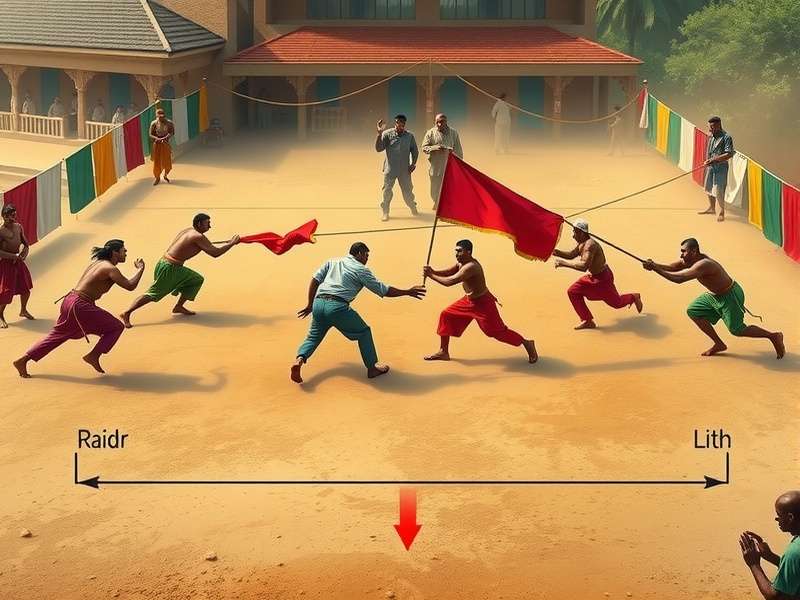What is Ultimate Kabaddi? 🏃♂️
Ultimate Kabaddiis a traditional Indian contact team sport that combines elements of wrestling, tag, and strategic gameplay. Played between two teams of seven players each, the objective is for a single "raider" to enter the opponent's half, tag as many defenders as possible, and return to their own half - all in a single breath while chanting "kabaddi, kabaddi".
The game demands exceptional physical fitness, breath control, strategic thinking, and lightning-fast reflexes. Ultimate Kabaddi has evolved from rural playgrounds to international arenas, captivating millions with its unique blend of simplicity and complexity.
Did You Know?
The word "kabaddi" originates from the Tamil word "kai-pidi" meaning "holding hands" - reflecting the game's defensive teamwork essence.

ModernUltimate Kabaddicompetitions feature highly trained athletes who have elevated the sport to new heights of professionalism and excitement. The Pro Kabaddi League in India has been instrumental in popularizing the sport globally, attracting international players and substantial viewership.
Historical Origins & Evolution 📜
The origins ofUltimate Kabaddican be traced back over 4000 years to prehistoric India. Historical evidence suggests similar games were played in different regions under various names: "Chedugudu" in Andhra Pradesh, "Ha-do-do" in Eastern India, and "Hu-Tu-Tu" in Western India.
Ancient texts and mythological references indicate that kabaddi-like games were played to develop defensive skills, particularly among warriors. The game was mentioned in the Hindu epic Mahabharata, where Abhimanyu's penetration of the Chakravyuha formation is often compared to a kabaddi raid.
Modern Formalization
Kabaddi was standardized in the early 20th century, with the first organized competitions taking place in the 1920s. The All India Kabaddi Federation was formed in 1950, establishing uniform rules and promoting the sport nationally.
International Recognition
Kabaddi gained international recognition when it was included in the 1990 Asian Games in Beijing. Since then, it has become a regular fixture in Asian Games and has spread to over 65 countries worldwide.

Game Rules & Regulations 📋
Understanding the rules is essential to appreciate the strategic depth ofUltimate Kabaddi. The game combines simple concepts with complex tactical execution.
Basic Objective
Teams take turns sending a "raider" into the opponent's court. The raider must tag defenders and return to their half while continuously chanting "kabaddi" in one breath.
Scoring System
Points are scored when a raider successfully tags opponents and returns to their half (1 point per defender tagged). Defenders score by preventing the raider's return (1 point). Additional points are awarded for "all-outs" (eliminating all opponents).
Court Specifications
The kabaddi court measures 13×10 meters for men and 12×8 meters for women, divided into two halves. Each half contains a "bonus line" that offers extra points when crossed during a raid.
Match Duration
A standard match consists of two halves of 20 minutes each with a 5-minute break. The team with the most points at the end wins. In case of a tie, extra time of 7 minutes is played.

Playing Techniques & Strategies 🥋
MasteringUltimate Kabaddirequires proficiency in various offensive and defensive techniques. Players spend years perfecting these skills to excel at competitive levels.
Raiding Techniques
Toe Touch
Quickly touching the defender's foot with a swift leg movement, effective against cautious defenders.
Running Hand Touch
Sprinting past defenders while extending an arm to tag them, requiring exceptional speed and timing.
Dubki
Ducking under a defender's attempt to capture, demonstrating agility and body control.
Defensive Strategies
Chain System
Defenders form coordinated chains to surround and capture raiders, requiring perfect timing and communication.
Ankle Hold
A specialized technique where defenders grab the raider's ankle to stop their movement and facilitate capture.
Major Tournaments & Leagues 🏆
The popularity ofUltimate Kabaddihas spawned numerous prestigious tournaments that showcase world-class talent and attract massive audiences.
| Tournament | Established | Significance | Nations |
|---|---|---|---|
| Pro Kabaddi League | 2014 | Revolutionized kabaddi with professional teams, high production values, and international players | 12+ |
| Kabaddi World Cup | 2004 | International championship featuring national teams from around the world | 20+ |
| Asian Games | 1990 | Multi-sport event where kabaddi has been a regular medal sport since 1990 | 15+ |
| National Kabaddi Championships | 1952 | Premier domestic competition in India featuring state teams | 1 |
Dominant Nations
India has historically dominated international kabaddi, winning all Asian Games gold medals until 2018 when Iran claimed the men's title, signaling the sport's growing global competitiveness.
Physical & Mental Benefits 💪
PlayingUltimate Kabaddioffers comprehensive health benefits that extend beyond physical fitness to mental and emotional well-being.
Respiratory Development
The continuous chanting requirement strengthens lung capacity and breath control, benefiting overall cardiovascular health.
Cognitive Enhancement
Quick decision-making under pressure sharpens reflexes, strategic thinking, and situational awareness.
Teamwork Skills
Coordinated defense and strategic raiding foster communication, trust, and collaborative problem-solving.
Physical Fitness
Develops strength, agility, flexibility, and endurance through dynamic movements and constant action.
Cultural Significance & Global Spread 🌍
Ultimate Kabaddiis more than just a sport in India - it represents cultural heritage, community bonding, and national pride. The game is deeply embedded in rural traditions and festivals.
In villages across India, kabaddi tournaments are central to community celebrations, often organized during festivals and harvest seasons. These events strengthen social bonds and preserve cultural practices passed down through generations.
The global expansion of kabaddi has been remarkable, with established federations in over 65 countries. Nations like Iran, South Korea, Japan, Kenya, and Argentina have developed competitive teams, transforming kabaddi from a regional pastime to an international sport with growing Olympic aspirations.
Cultural Preservation
Kabaddi maintains its traditional essence while adapting to modern competitive standards, serving as a living bridge between ancient traditions and contemporary sports culture.